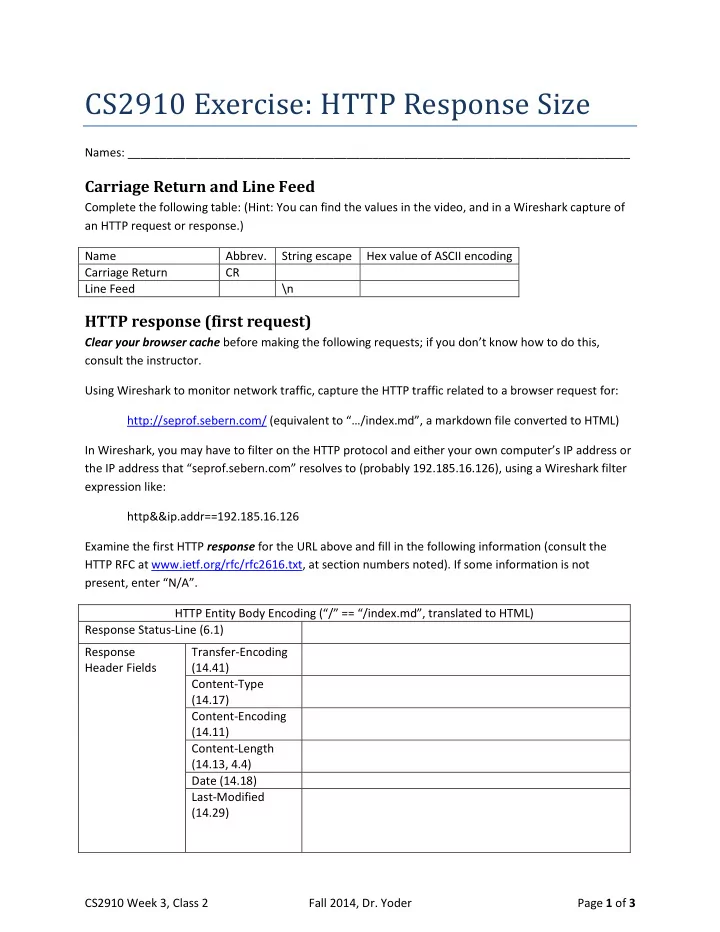

CS2910 Exercise: HTTP Response Size Names: ______________________________________________________________________________ Carriage Return and Line Feed Complete the following table: (Hint: You can find the values in the video, and in a Wireshark capture of an HTTP request or response.) Name Abbrev. String escape Hex value of ASCII encoding Carriage Return CR Line Feed \n HTTP response (first request) Clear your browser cache before making the following requests; if you don’t know how to do this, consult the instructor. Using Wireshark to monitor network traffic, capture the HTTP traffic related to a browser request for: http://seprof.sebern.com/ (equivalent to “…/index.md”, a markdown file converted to HTML) In Wireshark, you may have to filter on the HTTP protocol and either your own computer’s IP address or the IP address that “seprof.sebern.com” resolves to (probably 192.185.16.126) , using a Wireshark filter expression like: http&&ip.addr==192.185.16.126 Examine the first HTTP response for the URL above and fill in the following information (consult the HTTP RFC at www.ietf.org/rfc/rfc2616.txt, at section numbers noted). If some information is not present, enter “N/A”. HTTP Entity Body Encoding (“/” == “/index.md”, translated to HTML) Response Status-Line (6.1) Response Transfer-Encoding Header Fields (14.41) Content-Type (14.17) Content-Encoding (14.11) Content-Length (14.13, 4.4) Date (14.18) Last-Modified (14.29) CS2910 Week 3, Class 2 Fall 2014, Dr. Yoder Page 1 of 3
Actual entity (Briefly explain body size how this was determined) Other questions or comments HTTP Response (2 nd request) Examine the HTTP response for the URL http://seprof.sebern.com/sebern1.jpg and fill in the following information (you may wish to refer to the HTTP RFC at www.ietf.org/rfc/rfc2616.txt ). If some information is not present, enter “N/A”. HTTP Entity Body Encoding (“/” == “/index.md”, translated to HTML) Response Status-Line (6.1) Response Transfer-Encoding Header Fields (14.41) Content-Type (14.17) Content-Encoding (14.11) Content-Length (14.13, 4.4) Date (14.18) Last-Modified (14.29) Actual entity (Briefly explain body size how this was determined) Other questions or comments CS2910 Week 3, Class 2 Fall 2014, Dr. Yoder Page 2 of 3
Chunking For the HTTP response above that uses chunking for the entity body, list the number of bytes (as displayed in the reassembled TCP tab) in each part of the HTTP chunked response, filling in the table below. When summed, do these match your measurement for the actual size of the entity body above ? If not, figure out why and correct the discrepancy. Wireshark automatically interprets these fields, and names them with the names given below. The repeated copies of field-names are for different chunks. For the Chunk Size field, give the number of bytes used to store the chunk size (including the CRLF), not the number encoded in hexadecimal. Depending on how many chunks there are in the response, you may not have all the fields listed here. Field Number of bytes in Field Number of bytes in entity body (decimal) entity body (decimal) Chunk size Chunk size Data Data Chunk Chunk boundary boundary Chunk size Chunk size Data Data Chunk Chunk boundary boundary Chunk size Chunk size Data Data Chunk Chunk boundary boundary Chunk size Chunk size Data Data Chunk Chunk boundary boundary Total: Additional HTTP requests and responses If you have time, 1. Examine the response when requesting the image file a second time. What is different (if anything)? 2. Which fields are used to determine whether the additional resources are re-sent? CS2910 Week 3, Class 2 Fall 2014, Dr. Yoder Page 3 of 3
Recommend
More recommend